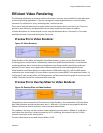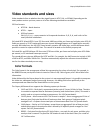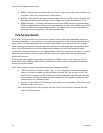AVStream Driver Reference Information
76 ViewCast
RGB24 – Each pixel has three bytes (24 bits) of data – one each for red, green, and blue. This
is another “true color” mode with 16.7 million colors.
RGB555 – Each pixel has two bytes (16 bits) of data. There are 5 bits each of red, green, and
blue data; the sixteenth bit is unused. This is a “high color” mode, also known as “5:5:5.”
RGB8 (Greyscale) – The Osprey AVStream driver uses the RGB8 format for greyscale video.
RGB8 is a palletized format. Each pixel is represented by one byte, which indexes one of 256
colors in a color palette specified by the driver. The Osprey driver sets the color palette to
greyscale entries, and captures “Y8” luminance-only data.
YUV format details
YUY2, UYVY, YVU9, and YUV12 are YUV formats. In these formats, each pixel is defined by intensity or
luminance component, Y, and two color or chrominance components, U and V. Because the human eye
is less sensitive to color information than to intensity information, many video formats save storage
space by having one luminance byte per pixel while sharing the chrominance byte among two or more
pixels. YUV is also similar to the color encoding used for analog color television broadcast signals.
YUY2 mode, sometimes referred to as 4:2:2 packed mode, consists of a single array of mixed Y, U, and V
data. Each pixel has one Y (intensity) byte. Each pixel shares its U and V bytes with one of the pixels
horizontally next to it.
YUY2 uses the same number of aggregate bytes per pixel as RGB15, which is two. However, YUY2 is
more efficient than RGB15 because it stores relatively more of the intensity information to which the
human eye is most sensitive.
UYVY mode is similar to YUY2 except that the bytes are swapped as follows:
YVU9 and YVU12 are “planar” modes – the Y, U, and V components are in three separate
arrays. It is easiest to explain the format with an example: Let’s say you have a 320 x 240
YVU9 format. The buffer has 320 x 240 bytes of Y data, followed by 80 x 60 bytes of V data,
followed by 80 x 60 bytes of U data. So each U and each V byte together contain the color
information for a 4 x 4 block of pixels.
Similarly, a 320 x 240 YUV12 format has a 320 x 240 Y array, followed by a 160 x 120 U array,
and then a 160 x 120 V array.
Note: In the I420 format used by Osprey, the order of the U and V arrays is reversed from the
order in the YVU9 format.


















